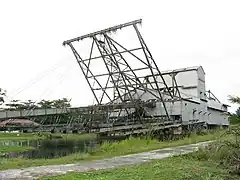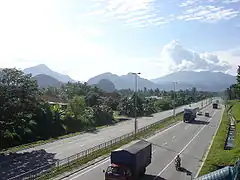The Kinta Valley is a conurbation in central Perak, Malaysia, surrounding and including the state capital Ipoh. Historically the Kinta Valley was very rich in tin, and their mines have been among the most productive in the world. The valley is formed by the Kinta River, a tributary of the Perak River, which flows between the Titiwangsa Mountains and the Kledang Range.
It forms the largest tin field along the Siamese-Malayan peninsula tin belt. It has been mined since ancient times by indigenous peoples but more intensively mined by the Chinese and Europeans since the end of the nineteenth century. Today, the modern Kinta district is one of the ten administrative districts of Perak.[1] In 2018, the valley was declared Malaysia's second national geopark.[2]
Geographic definition

The Kinta Valley Conurbation is officially known as Zon Promosi Pembangunan (ZPP) Ipoh in the fourth National Physical Plan (NPP-4).[3] Centred in the city of Ipoh, the metropolitan area spans all of Batu Gajah and Kampar, as well as parts of Kuala Kangsar, Perak Tengah and Manjung municipalities. As of 2020, Kinta Valley had a population of 1.28 million, making it the fourth largest metropolitan area in Malaysia.
| City or town | Local government | Population[4] |
|---|---|---|
| Ipoh | Ipoh City Council | 759,952 |
| Batu Gajah | Batu Gajah District Council | 126,024 |
| Kampar | Kampar District Council | 97,216 |
| Sungai Siput | Kuala Kangsar Municipal Council | 62,856 |
| Bota | Perak Tengah District Council | 30,799 |
| Seri Iskandar | 14,827 | |
| Ayer Tawar | Manjung Municipal Council | 3,050 |
| Damar Laut | 13 | |
| Pekan Gurney | 1,622 | |
| Lumut | 59,554 | |
| Sitiawan | 126,547 | |
| Kinta Valley Conurbation | 1,282,460 | |
History
The Kinta Valley was occupied for thousands of years by the ancestors of the Orang Asli. Prehistoric remains include the Tambun rock art. The Kinta Valley has been visited for tin by Indian traders since ancient times. Buddhist bronze artefacts have been excavated in Kinta in 1931.[5]
Mining
Early mining methods
An early method of indigenous mining was the Lombong Siam, meaning Siamese mines.[6] Malay miners used ground sluicing or the lampan method by cutting ditches from the nearest river.[7] In the nineteenth century, Mandailing migrants from Sumatra were observed using the tabuk mine, which is an excavated pit from which water is removed by cantilevered baskets.[8]
Chinese mining
The first tin rush to Kinta lasted from 1884 to 1889 where new land was taken up by Chinese miners using labour-intensive methods. Hailing from the farmlands of Guangdong, the Chinese mining workers at first used agricultural implements such as hoes, rakes and baskets to excavate the earth. The Chinese also introduced the water wheel to dewater the mines. The second tin rush lasted from 1889 to 1895, and was characterised by small gangs of tributers using the wooden sluice box (lanchut kechil).[9] Around the turn of the twentieth century, two of the most famous large Chinese mines were the Tambun Mines, owned by Leong Fee, and Tronoh Mines, owned by Foo Choo Choon.[9] There were many successful Chinese miners too like Eu Tong Sen, Chop Thai Lee, Chung Thye Phin, Au Moh Yi, Yau Tet Shin, Khi Ho Nin, Shak Yin Fuk,[10] Lam Look Ing and Aw Kong. Up till the late twentieth century, Chinese women miners could be commonly observed panning tin with wooden trays (dulang) from stream-beds and tailing dumps of tin mines.
European mining
The longest operating European mine in the Kinta Valley was the French Société des Etains de Kinta[11] better known as SEK, which started operating in 1886 and only closed down in 1985.[12] Foo Choo Choon's Tronoh Mines was floated in London and became a European concern. Several opportunities arose for Osborne, founder of the Gopeng tin mining Company, who expanded his business by forming the famous professional partnership of Osborne & Chappell in 1901.[13]
Dredging

In 1913, dredging was put into practice by Malayan Tin Dredging Ltd. (MTD), which later became the largest tin dredging company in the world. It had a significant impact on Kinta in terms of technological advancement. The bucket dredge was introduced and was the final breakthrough of the Malayan tin mining industry.[14]
The last surviving dredge can be found at Batu Gajah along Jalan Tanjung Tualang. It belongs to Southern Malaya Tin Dredging.
See also
References
- ↑ Kinta Valley. 2015. Encyclopædia Britannica.
- ↑ Bunyan, John. "Kinta Valley declared Malaysia's second national geopark". Malay Mail. Retrieved 19 September 2020.
- ↑ "Rancangan Fizikal Negara Keempat: Pelan Pengurusan Spatial Negeri" (PDF). Ministry of Local Government Development. October 2021.
- ↑ "Mukim > Bandar George Town". Department of Statistics Malaysia. Retrieved 29 December 2023.
- ↑ Evans, Ivor H. N., 'Buddhist Bronzes From Kinta, Perak', Journal of the Federated Malay States Museums, Vol. XV, Part 3, August, 1932: 135-6
- ↑ Hale, A., 'On Mines and Miners in Kinta, Perak', Journal of Malayan Branch Royal Asiatic Society, Vol. 16, 1885: 304
- ↑ Everitt, 'Fifty Years of Tin Mining in Malaya', Malaya, November 1952: 50-51
- ↑ Hale, A.,'On Mines and Miners in Kinta, Perak', Journal of Malayan Branch Royal Asiatic Society, Vol. 16, 1885: 315
- 1 2 Khoo Salma Nasution and Adbur-Razzaq Lubis, 2005. Kinta Valley: Pioneering Malaysia's Modern Development. Ipoh: Perak Academy. ISBN 983-42113-09
- ↑ Tak Ming Ho. 'Generations: The Story of Batu Gajah'. 2005.
- ↑ The Singapore Free Press and Mercantile Advertiser (1884–1942), Société des Etains de Kinta, 20 March 1908, Page 5.
- ↑ Wong Lin Ken, The Malayan Tin Industry to 1914 with special reference to the states of Perak, Selangor, Negri Sembilan and Pahang, Tucson: The University of Arizona Press, 1965: 146
- ↑ Palmer, David; Joll, Michael, Tin Mining in Malaysia, 1800-2000: The Osborne & Chappel Story, Muzium Gopeng, 2011.
- ↑ Ingham, F. T. and E. F. Bradford, The Geology and Mineral Resources of the Kinta Valley, Perak, Kuala Lumpur: Government Printer, 1960.
External links
![]() Media related to Lembah Kinta at Wikimedia Commons
Media related to Lembah Kinta at Wikimedia Commons

